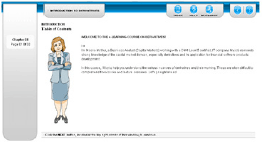|  The client The client
World's First CMMi Level 5 company providing IT solutions in the areas of banking, financial services, ERP, retail automation and risk management.
The problem
Operating in a competitive IT solutions and services market the company proposed to differentiate itself from the competition. In an attempt towards this end it redefined its value proposition. The value proposition identified was to equip its predominantly technical IT workforce with domain knowledge of the industry/area for which the company was developing software solutions.
A case in point was its programmers who developed backend applications for forex and debt market transactions and financial derivatives trading and settlement.
In this case, the programmers grappled with the development of software functions and applications for the financial instruments. The reasons, identified by the client were twofold: First, the non-financial academic background of the techies, which in turn led to the second; lack of motivation to attempt understanding the financial domain for which they developed applications.
Classroom-based, lecture-led training sessions were arranged for the techies to equip them with domain knowledge. With programmers spread across different graphic locations, the company had to limit the number of times and places it could replicate the training. Therefore, the company wanted a training programme that would complement the classroom training. This programme could also serve as a refresher, post classroom training.
The Solution
Having chosen e-Learning to complement the classroom-based training the company sought C&K ‘s help to develop the solution. C&K proposed to develop a 12-hour learning course covering four modules:
1. Derivatives including:
- a. Options
b. Forwards & Futures
c. Swaps & Interest rate derivatives
d. Credit Derivatives
2. Forex markets
3. Debt markets
4. Trading & Settlement
Considering the fact that the online course was not mandatory, it needed to be highly engaging to ensure greater participation.
Development and Implementation
At the outset, C&K carried out user analysis. A learning style inventory test was administered to 65 randomly chosen employees of the client to identify their preferred learning style. As expected, the predominant learning style among the sample was active/visual/sensor. Content analysis and technical analysis also led to useful inputs for the e-Learning course development. Additionally, C&K
- Used John M. Keller’s ARCS Model of Motivation Design for developing the course to enhance motivation among target learners. The ARCS Model provides a sound framework to instructional designers in order to increase the participation level of learners.
- Used a virtual pedagogical agent to engage the learner throughout the course and discuss/illustrate the learning objectives. The agent used situations involving buyer(s) and seller(s) to illustrate trade, clearance and settlement of various de rivative instruments.
- Extensively used activity-based and visually appealing learning aids throughout the course for learning to be effective, considering the active/visual learning style of the target learners.
- Complied the e-Learning solution with SCORM guidelines for easy deployment at the client’s LMS.
Results
The e-Learning solution is in the process of implementation at the client’s premises. Preliminary feedback received from the end users has been encouraging. |